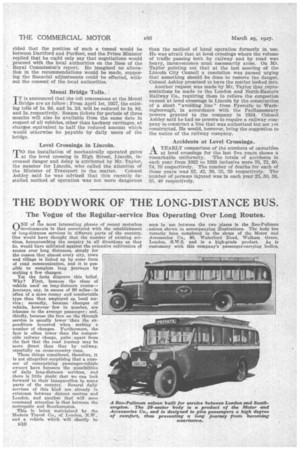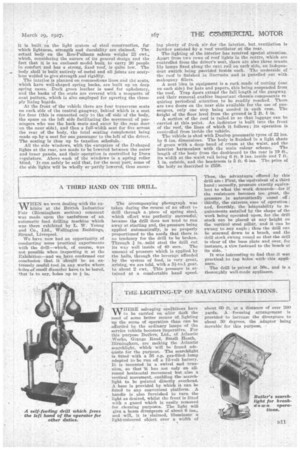THE BODYWORK OF THE LONG-DISTANCE BUS.
Page 80

Page 81

If you've noticed an error in this article please click here to report it so we can fix it.
The Vogue of the Regular-service Bus Operating Over Long Routes. •
ONE of the most interesting phases of recent motorbus developments is that associated with the establishment of long-distance services in different parts of the country. One would have thought that the number of existing services, honeycombing the country in all directions as they do, would have militated against the extensive cultivation of routes over long distances, simply for the reason that almost every city, town and village is linked up by some form of road communication, and it is possible to complete long journeys by making a few changes.
Yet the facts disprove this belief. Why? First, because the class of vehicle used on long-distance routes— journeys, say, in excess of 60 miles—is often of a more roomy and comfortable type than that employed on local service; secondly, because changes of vehicle, however feiv in number, are irksome to the average passenger ; and, thirdly, because the fare On the through service is usually tower than the expenditure incurred when making a number of changes. Furthermore, the fare is often lower than the comparable railway charge, quite apart from the fact that the road iourney may be more direct than that by railway, especially on cross-eountry runs.
These things considered, therefore, it Is not altogether surptising that a numnor of enterprising passenger-vehielir owners have foreseen the possibilities of daily long-distance services, and there is little doubt that we can look forward to their inauguration in many parts of the country. Several daily services of this kind are already in existence between distant centres and London, and another that will soon command attention is that between the metropolis and Southampton.
This is being maintained by the Modern Travel Co., of London, N.W,, and a vehicle which will shortly be seen in use between the two places is the Reo-Pullman -saloon shown in accompanying illustrations. The body has recently been completed in the shops of the Motor and Accessories Co., 40, Waterford Road, Walham Green, London, S.W.6, and is a high-grade product. As is customary with this company's passenger-carrying bodies, it is built on the light system of steel construction, far which lightness, strength and durability are claimed. The actual body on the Hen-Pullman saloon weighs 23 cwt., which, considering the nature of its general design and the fact that it is an enclosed model built to carry 26 people in comfort and has a strong, fixed -roof, is quite low. The body shell is built entirely of metal and all joints arc acetylene welded to give strength and rigidity. The interior is planned on commodious lines and the seats, which have well-shaped spring backs, are built up on deep spring cases. Dark green leather is used for upholstery, and the backs of the seats are covered with a moquette of cleat pattern, which is also employed for cevering the threeply lining boards.
At the front of the vehicle there are four transverse seats on each side of the central gangway, behind which is a seat for four (this is connected only to the off side of the body, the space on the left side facilitating the movement of passengers who use the back seats and enter by the rear door on the near side), and then a full-width seat for five across the rear of the body, the total seating complement being made up by a seat for one passenger to the left of the driver. The seating is thus up to taxation schedule. •
All the side windows, with the exception of the fl-shaped lights at the rear, are made to be lowered between the outer and inner panels, and their operation is controlled by Dural regulators. Above each of the windows is a spring roller blind. It can safely be said that, for the most part, some of the side lights will be wholly or partly lowered, thus ensur
jug plenty of fresh air for the interior, but ventilation is further assisted by a roof ventilator at the rear.
The lighting of the interior has received special attention. Apart from two rows of roof lights in the centre, which are controlled from the driver's seat, there are also three ornate lily lamps fixed along the cant rail on each side, an independent switch being pRovided beside each. The underside of the roof is finished in lincrusta and is panelled out with mahogany fillets.
A neat idea in equipment is a rack made of netting (one on each side) for hats and papers' this being suspended from the roof. Trap doors extend the full length of the gangway. and their removal enables important chassis components re gulling periodical attention to be readily reached. There are two doors on the near side available for the use of passengers, only one step being needed in each case. The teight of the floor level from the ground is 2 ft. I in.
A section of the roof is tailed in so that luggage can be carried at this point. An indicator is built into the front of the roof, the lines of which it follows ; its operation is controlled from inside the vehicle.
The vehicle is shod with Dunlop pneumatic tyres of 32 ins. by 6 ins. dimensions. The body is finished in a light shade of green with a deep band of cream at the waist, and the interior harmonizes with the main colour scheme. The length of the body from the dashboard to the rear is 19 ft., its width at the waist rail being 6 ft. 9 ins, inside and 7 ft. 1 in. outside, and the headroom is 5 ft. 6 ins. The price of the body as described is 1550.












































































































































































